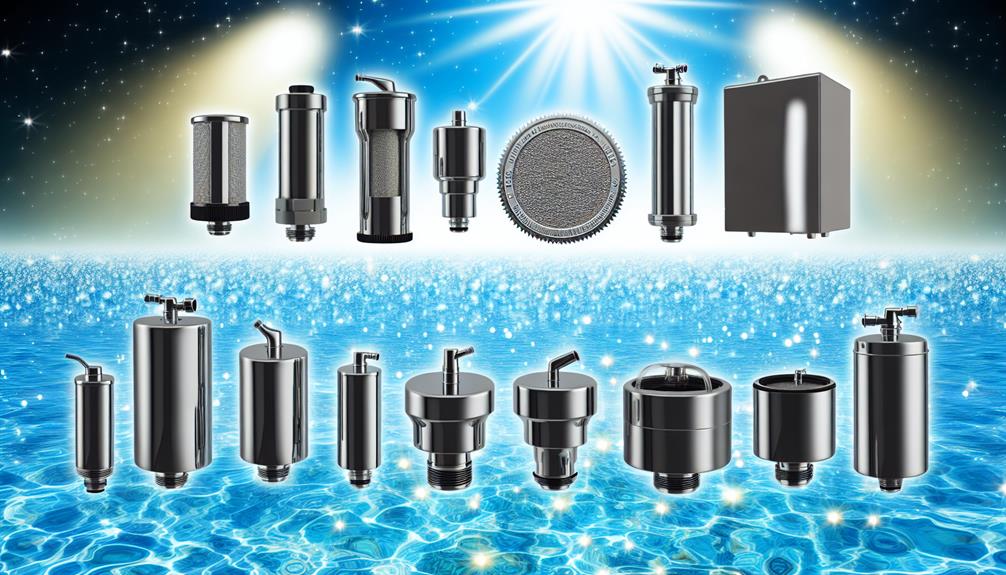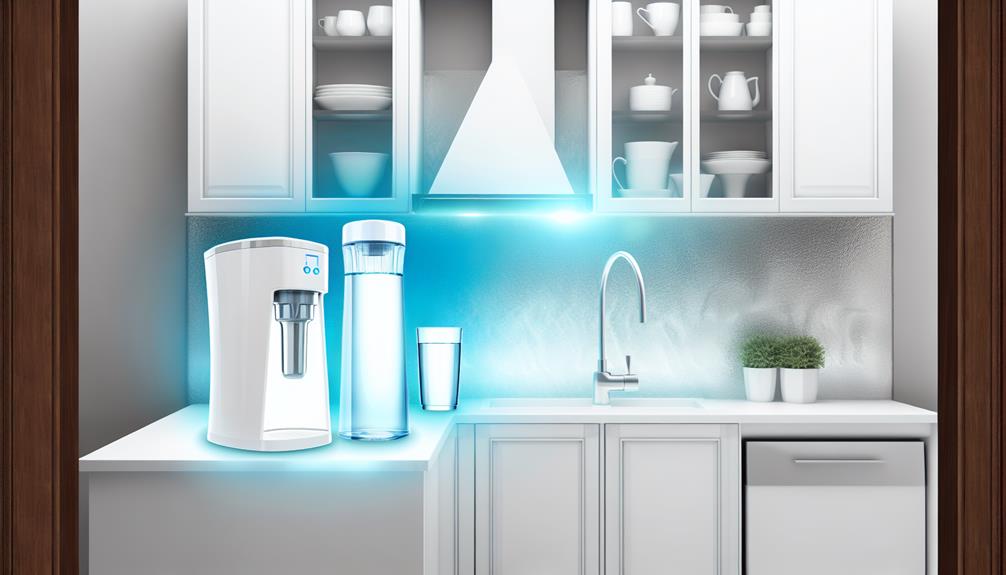Just as a fortress is tested for its strength against invaders, so too must water filters be rigorously challenged to protect against the unseen contaminants threatening your health.
You're aware that safe drinking water is fundamental, but with a market flooded by countless filtration systems, you might find yourself navigating a sea of options without a compass.
The filters that have made it to this list have not only passed the muster of health safety standards but have risen to the top through a combination of certified multi-stage filtration, reverse osmosis purity, and specific contaminant removal efficiencies.
Whether you're looking to invest in a pitcher filter, an under-sink solution, or a whole house filtration system, it's essential to know which will offer you the fortress-like security you need.
Stay tuned to uncover which filters have the mettle to make the water from your tap as pure as nature intended, and why they deserve a place in your home.
Certified Multi-Stage Filtration
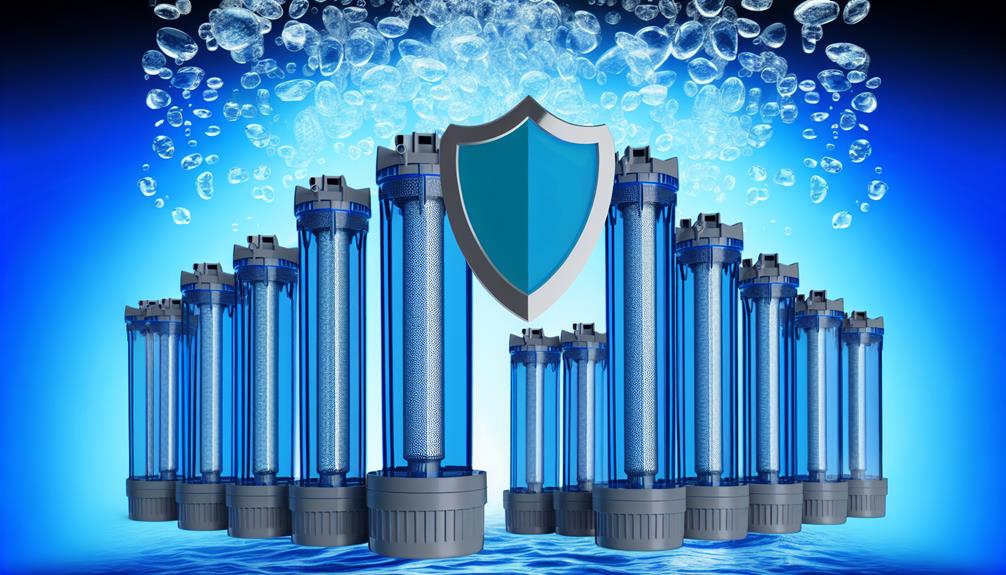
To safeguard your health, certified multi-stage filtration systems employ a sequential process that targets and removes various contaminants from your water supply. These systems are meticulously designed to address a broad spectrum of impurities, such as particulates, chemicals, and heavy metals that could pose a risk to your well-being. The efficacy of this filtration process is contingent upon the coordination of multiple filters, each responsible for eradicating specific contaminants.
Analyzing the filter cost is crucial when considering a multi-stage system. Higher upfront expenses are often justified by the durability and efficiency of the system, leading to long-term savings. Premium filters may demand a steeper investment, but they're engineered to last longer and perform better, reducing the frequency of replacements and maintenance costs.
Taste improvement is a tangible benefit of these systems. By removing substances like chlorine and lead, which can impart unpleasant flavors and odors to water, multi-stage filtration enhances the sensory quality of your drinking water. This isn't merely a superficial advantage; it's indicative of the removal of potentially harmful constituents, confirming the system's effectiveness. Consequently, you're not just enjoying better-tasting water, you're also consuming a product that aligns with stringent health safety standards.
Reverse Osmosis Purity
Reverse osmosis systems offer an exceptional level of purity by forcing water through a semi-permeable membrane that captures contaminants as small as 0.0001 microns. This membrane technology isn't only pivotal for providing clean drinking water but also plays a crucial role in wastewater reuse, ensuring that minimal pollutants return to the environment.
When analyzing reverse osmosis for its efficiency and effectiveness, consider the following:
- Contaminant Removal: Reverse osmosis membranes can remove up to 99% of dissolved salts (ions), particles, colloids, organics, bacteria, and pyrogens from the feed water.
- Water Pressure: The process requires a certain amount of pressure to overcome osmotic pressure; the more contaminated the water, the higher the pressure needed.
- Maintenance: Membrane longevity and performance are highly dependent on regular maintenance, including pre-filtration to protect the membrane from clogging or damage.
- Efficiency: Modern reverse osmosis systems are becoming more efficient, with some units designed to recover more than 90% of the feed water.
You're looking at a technology that's not only about achieving high purity levels but also about maximizing resource efficiency and reducing the environmental impact of wastewater. With continuous advancements, reverse osmosis remains a top contender in water treatment solutions meeting stringent health safety standards.
Lead Removal Efficiency
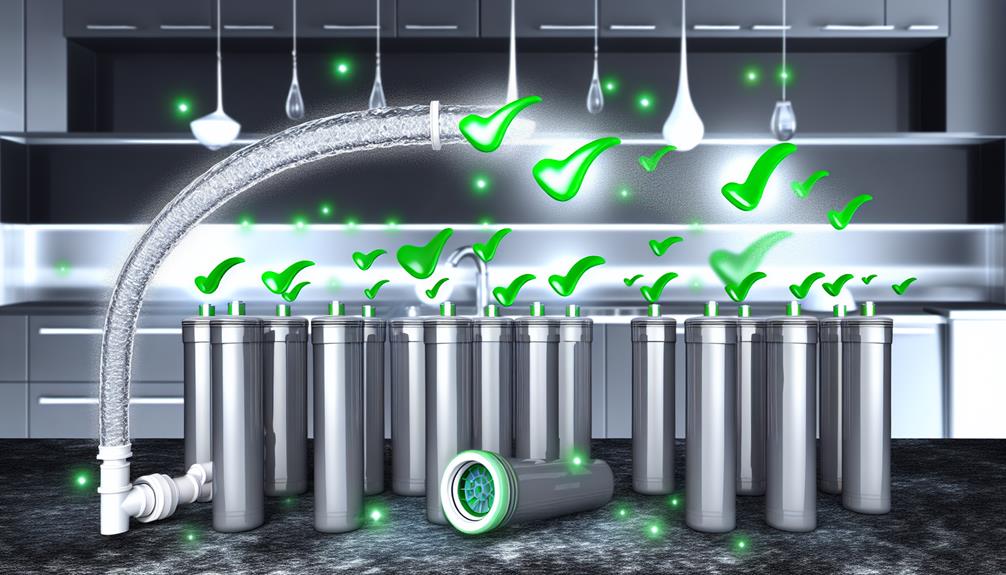
Regarding lead removal capabilities, water filters certified by NSF/ANSI Standard 53 are known to effectively reduce lead concentrations in drinking water to below the action levels set by the Environmental Protection Agency (EPA). As you seek to protect your family from the toxic effects of lead ingestion, it's essential to understand that not all filters are equal in their filtration performance.
| Concern | Impact |
|---|---|
| Lead Exposure | Causes developmental issues in children and cardiovascular problems in adults. |
| Lead Reduction | NSF/ANSI 53 certified filters can reduce lead by over 99%. |
| Copper Reduction | Minimizes risks associated with copper, including liver damage and kidney disease. |
| Taste Improvement | Filters that remove metallic contaminants often improve the water's taste, making hydration more enjoyable. |
These filters not only target lead but often incorporate copper reduction, ensuring that both elements are significantly decreased, enhancing the overall safety of the water you consume. In addition to health benefits, these filters typically contribute to taste improvement, providing a better sensory experience and encouraging more water consumption.
When you select a high-quality filter with proven lead removal efficiency, you're making an informed decision to safeguard your health. The technical superiority of these systems is quantifiable, with independent testing confirming their ability to meet stringent health safety standards.
Chlorine Filtration Performance
While NSF/ANSI 53 certified filters adeptly reduce hazardous lead levels, they're also typically equipped to diminish chlorine, a common chemical used in municipal water treatment that can affect taste and odor. You're likely seeking a filter that not only ensures safety but also enhances your drinking experience through taste improvement and reducing aesthetic impact.
Let's analyze the chlorine filtration performance of these filters:
- Chlorine Reduction Rate: Top-tier filters boast a 97% or higher chlorine reduction rate. This level of efficiency is critical for significantly improving the palatability of your tap water.
- Filter Longevity: A robust filter maintains optimal chlorine removal throughout its lifespan, which is quantified by the number of gallons it can treat effectively.
- Testing and Certification: Look for filters that have undergone rigorous testing by independent bodies such as NSF International to validate their chlorine filtration claims.
- Technological Advancements: Innovative technologies, such as combination filters utilizing activated carbon and catalytic media, are instrumental in achieving superior chlorine removal.
You'll find that high-performing filters deliver on both safety and sensory fronts. By choosing a filter with proficient chlorine filtration performance, you ensure not just health compliance but also a more enjoyable drinking experience, free from the unpleasant taste and odor associated with chlorinated water.
Longevity and Durability Tests
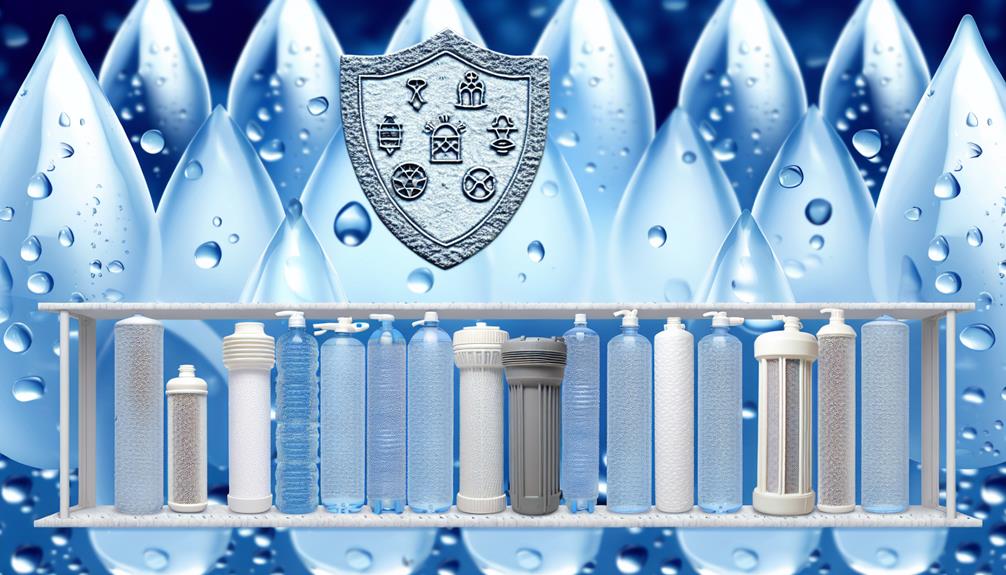
You must consider filter lifespan benchmarks to evaluate the long-term value of your water filter.
Standards for durability certification provide a quantifiable metric to gauge the robustness of different models under typical usage scenarios.
Regular maintenance and timely replacement are critical to ensure your filter continues to meet health safety standards throughout its use.
Filter Lifespan Benchmarks
Assessing the longevity and durability of water filters requires stringent benchmarking against established health safety standards to ensure they maintain efficacy over time.
When determining if a water filter is a sound investment, you must consider:
- Filter Replacement Frequency: Analyze the mean time between replacements to predict long-term filter costs.
- Mechanical Integrity: Evaluate stress test results that simulate years of operational cycles.
- Installation Requirements: Scrutinize the complexity of installation, which can affect long-term stability and performance.
- Material Degradation: Inspect the resistance of filter components to chemical and physical degradation over time.
A technical evaluation of these factors will provide a comprehensive understanding of the product's durability, ensuring that the filter remains a cost-effective and reliable choice for safe water consumption.
Durability Certification Standards
Having considered the factors that predict a water filter's long-term performance, let's examine the established Durability Certification Standards that quantify these filters' longevity and robustness through rigorous testing.
These standards assess the resilience of filter materials to a variety of stressors, including chemical exposure, pressure changes, and physical wear. You'll find that certified filters have undergone extensive evaluation to ensure that their performance doesn't degrade over time.
Installation protocols also play a crucial role in maintaining the integrity of the system. Properly installed and maintained according to manufacturer specifications, certified water filters are more likely to retain their efficacy and structural stability, providing you with reliable water purification for the duration of their service life.
Maintenance and Replacement Cycles
To ensure optimal performance over their lifespan, water filters must adhere to strict maintenance and replacement schedules, which are informed by comprehensive longevity and durability tests. Analyzing the data from these tests, you can make informed decisions about the filters you rely on.
Consider the following:
- Filter alerts: Advanced systems offer automated reminders for maintenance, minimizing human error and ensuring timely action.
- Installation considerations: Some filters require professional setup to ensure they function correctly and last as intended.
- Manufacturer's guidelines: Always follow the recommended replacement cycles to maintain water quality and system integrity.
- Tested durability: Filters should withstand the rigors of usage patterns as proven by endurance testing, dictating when a replacement is due.
Adherence to these elements is crucial for the long-term efficacy and safety of your water filtration system.
Bacteria and Virus Protection
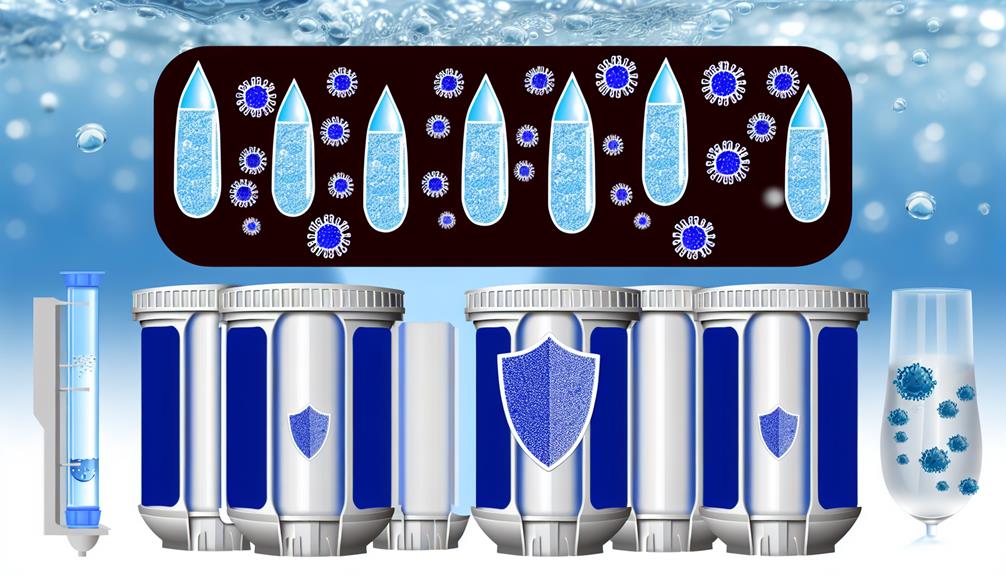
When selecting a water filter, you must consider its pathogen filtration efficiency, which reflects the filter's capability to eliminate bacteria and viruses.
The microbial removal rate, often expressed as a percentage, provides a quantifiable measure of a filter's effectiveness against specific pathogens.
To ensure safety, choose filters that meet or exceed regulatory standards for pathogen removal, as confirmed by independent testing.
Pathogen Filtration Efficiency
Water filters must exhibit high efficacy in removing or inactivating pathogens, such as bacteria and viruses, to comply with health safety standards. Utilizing nano filtration technology and ultrafiltration capabilities, these systems achieve remarkable pathogen filtration efficiency through:
- Physical barrier exclusion, where pore sizes are small enough to block passage of microorganisms.
- Charge-based rejection, leveraging the electrostatic repulsion between charged filter materials and pathogens.
- Mechanisms of adhesion, including biofouling, which traps pathogens onto filter surfaces.
- Inactivation via embedded materials that disrupt pathogens' cellular integrity.
These processes must be rigorously tested and validated under various conditions, ensuring that they can consistently remove or deactivate pathogens to safe levels.
Consequently, the concentration of pathogens is reduced to meet or exceed health safety standards, providing you with cleaner, safer drinking water.
Microbial Removal Rate
Building on the filtration technologies discussed, it's crucial to examine the microbial removal rate, as this metric directly reflects a water filter's ability to protect against bacteria and viruses. This rate is typically presented as a percentage, indicating the efficacy of a filter at reducing or eliminating pathogenic microorganisms. It's a critical factor, especially when considering the safety of drinking water in areas prone to microbial contamination.
High-performance filters achieve a microbial removal rate close to 99.99% for bacteria and viruses, significantly reducing the risk of waterborne diseases. Additionally, advanced filters are designed to meet cyst reduction standards, ensuring protozoa such as Giardia and Cryptosporidium are effectively removed. This not only enhances safety but also contributes to taste improvement by eliminating odors and flavors associated with microbial presence.
Here's a concise table illustrating these aspects:
| Filter Feature | Effectiveness |
|---|---|
| Bacteria Removal | >99.99% |
| Virus Removal | >99.99% |
| Cyst Reduction | Meets NSF 53 |
| Taste Improvement | Enhanced |
| Safety Standard Compliance | Yes |
Heavy Metal Contamination Solutions
To effectively mitigate the risks associated with heavy metal contamination in drinking water, it's essential to employ filtration systems that adhere to the latest health safety standards. These systems not only aim for sediment reduction, enhancing the clarity of your water, but also significantly contribute to taste improvement, removing the metallic tang often associated with heavy metals.
When selecting a water filter for heavy metal removal, consider the following:
- Ion Exchange Technology: Filters using this method swap heavy metal ions in water with harmless ions, such as sodium or potassium, effectively reducing contaminants like lead and mercury.
- Reverse Osmosis Systems: These units push water through a semipermeable membrane, removing up to 99% of dissolved heavy metals, ensuring compliance with stringent health safety benchmarks.
- Activated Carbon Filters: While primarily known for organic contaminant removal, some carbon filters are also treated to adsorb heavy metals, though they may require frequent replacement to maintain efficacy.
- Certification Standards: Look for filters certified by recognized organizations, such as NSF International, which guarantee that the product meets specific health and safety requirements for heavy metal reduction.
Pitcher Filter Effectiveness
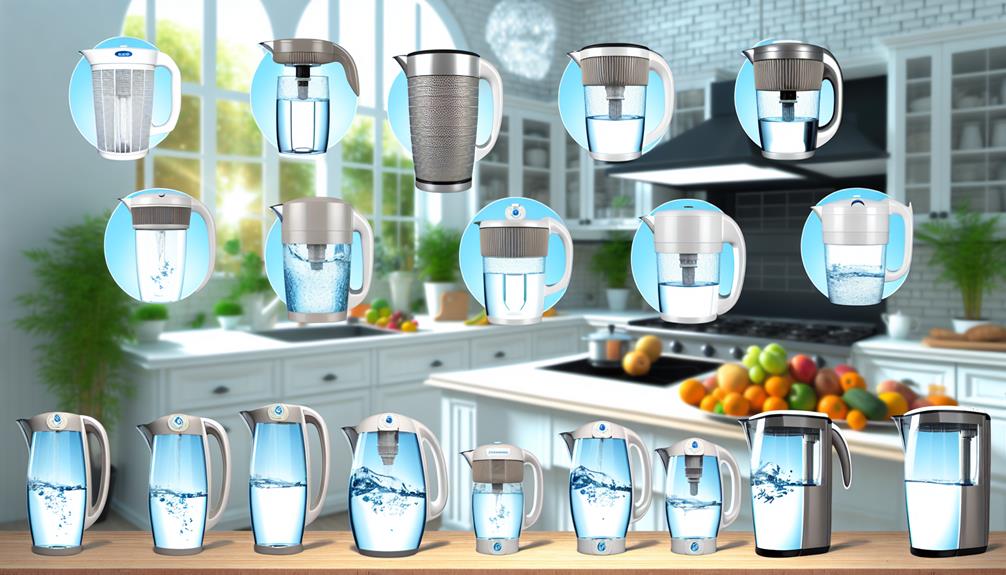
While considering the various technologies for heavy metal removal, it's crucial to evaluate the effectiveness of pitcher filters, which offer a convenient, though often less comprehensive, solution for water purification. You must recognize that pitcher filters mainly rely on activated carbon and ion-exchange resins to reduce contaminants. The carbon component is effective in adsorbing organic compounds, thereby significantly improving taste and eliminating odors. However, the capability to remove heavy metals varies substantially among models and brands.
Analyzing technical specifications, you'll notice that some pitcher filters are certified to reduce specific heavy metals, like lead and mercury, though their efficiency in dealing with a broader spectrum of contaminants can be limited. In terms of mineral retention, these filters generally don't strip beneficial minerals such as calcium and magnesium from the water, which are essential for maintaining a balanced mineral intake.
It's also vital to consider the maintenance requirements, as the effectiveness of pitcher filters decreases over time with usage. Regular replacement of filter cartridges is mandatory to sustain optimal performance.
Under-Sink Filter Advantages
Under-sink filters offer enhanced contaminant removal capabilities, directly addressing the limitations of pitcher filters by employing more advanced filtration technologies. When you're seeking a water filtration system that aligns with health safety standards, consider these under-sink filter advantages:
- Superior Filtration Performance: Multi-stage filters can remove a broader range of contaminants, including heavy metals, chemicals, and microorganisms, due to a more intricate purification process.
- Installation Ease: Manufacturers design under-sink filters for straightforward installation. You'll find that many models come with clear instructions and can be set up with basic DIY skills, avoiding the need for professional assistance.
- Space Saving Design: Unlike bulkier countertop options, under-sink filters are compact, fitting discreetly beneath your sink and preserving precious kitchen space.
- Continuous Supply: They provide a constant flow of purified water on demand, eliminating the waiting time associated with filling and refilling a pitcher.
An analytical approach reveals that the installation ease of under-sink filters doesn't compromise their efficacy. In fact, their space-saving design is an added benefit that complements their superior performance. When considering health safety, these systems offer a technically sound solution to water purification challenges.
Whole House Filtration Systems
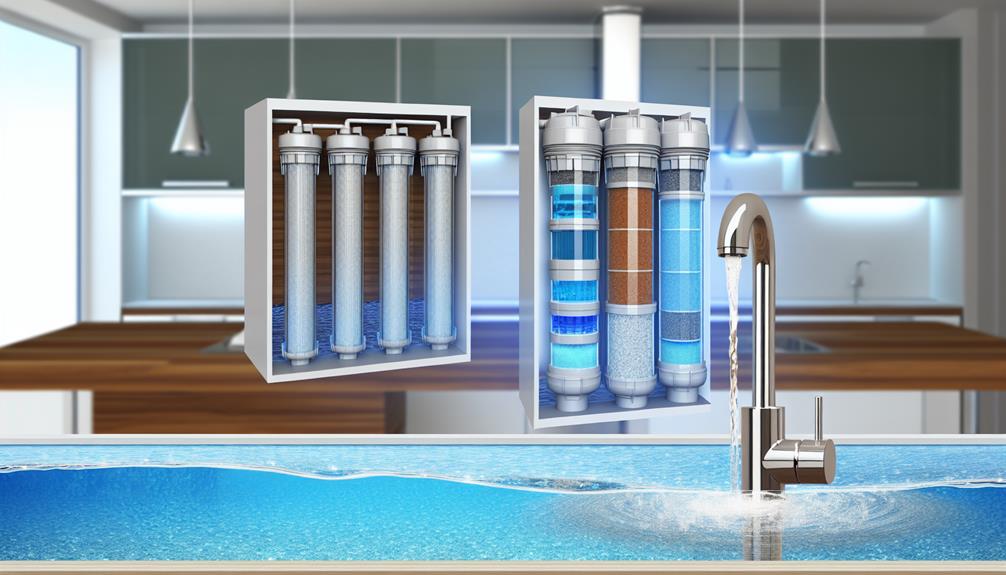
Whole house filtration systems provide a comprehensive solution for ensuring that all water entering your home meets stringent health safety standards. By installing a system at the point of entry, you're able to target contaminants before they distribute throughout your household pipes. These systems are particularly effective in sediment reduction, which is crucial for protecting your plumbing and appliances from the abrasive effects of particulate matter.
The technical design of whole house filters often includes multi-stage filtration. Typically, the first stage consists of a sediment pre-filter, which captures larger particles such as dirt, rust, and sand. Following this stage, additional filters, such as activated carbon or catalytic media, target chemical contaminants, chlorine, and certain organic compounds, contributing to taste improvement and removal of odors.
Evidence-based evaluations have shown that these systems can significantly reduce the presence of heavy metals, VOCs (volatile organic compounds), and other health-affecting substances. It's important to select a system certified by recognized standards like NSF/ANSI to ensure you're getting a filter that can meet or exceed health safety criteria.
Maintaining a whole house filtration system is relatively straightforward, usually requiring periodic replacement of cartridge filters. By keeping up with maintenance, you ensure the system's effectiveness and longevity, safeguarding your home's water supply consistently.
Conclusion
In conclusion, you've navigated the top-tier water filters that not only surpass health safety benchmarks but also deliver exceptional performance.
From multi-stage filtration to reverse osmosis, these systems effectively tackle contaminants, including lead, chlorine, and heavy metals.
You've seen the longevity of durable models, the convenience of pitcher filters, the thoroughness of under-sink units, and the comprehensive coverage of whole house systems.
Investing in any of these options ensures you're equipped with a scientifically verified solution for cleaner, safer water.
